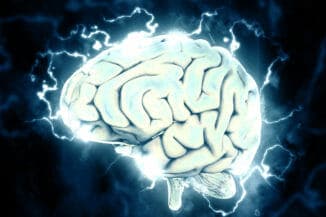
Brain alert! Gigantic brains are blooming in Bloomington, Indiana this spring and summer. Twenty-two enormous fiberglass brains (5 feet long, 5 feet high and 4 feet wide), each decorated by a specific artist and sponsored by a specific community-based organization, are dotting the campus of Indiana University and town of Bloomington from April 28 through autumn 2012. Conceived by Dr. Jill Bolte Taylor, the neuroanatomist who experienced a stroke in 1996 and went on to pen the best-selling memoir, “My Stroke of Insight: A Brain Scientist’s Personal Journey,” The Brain Extravaganza! project resembles the popular CowParade but this time it’s about us … and our brains. We recently caught up with Taylor.
Brain World: How were the artists selected?
Jill Bolte Taylor: We did another interview with the local paper, looking for artists. We asked them to fill out proposal forms that we had online, where we gave the dimensions of the brains and some information about what we were looking for, and we solicited their ideas and designs. We were fortunate that everyone who put in an original proposal ended up being an artist. All of them are local artists except for two; one is out of Chicago and another is from Miami University in Oxford, Ohio.
BW: Can you name a few of the guidelines?
JBT: The first thing it needed to be was anatomically correct. For example, there is a pain and sleep center as one of our sponsors, and the artist wanted to do pain in the front of the brain and sleep in the back of the brain. I said that neuroanatomically it isn’t organized front-to-back, but it is more or less top-to-bottom or side-to-side. The artist had to rewrap his mind around what his design was, and he was willing to work with the anatomy of the brain. Also, there are others who are writing things on the brain, and I want them written in the right places if they’re relative to function.
BW: You wanted to have an educational purpose.
JBT: Every brain will have a sign attached to its base that will have the name of the sponsor, artist and five brain facts that have something to do with the particular theme of that brain’s sponsor. There will then be a question that it will ask about you and your brain. There’s going to be a mobile phone app that you can download, and it will download a stained-glass brain that has 22 empty spots in it. And as you go from brain to brain, and as you answer that particular question — A, B, C, D, E, F — depending on what you answer, it will paint that specific part of the stained-glass brain a certain color.
BW: Wow!
JBT: Exactly, wow! We want kids to go around and paint their own brains and then upload their brain images onto their Facebook page. It becomes a cool thing. And we also have a certain section where we’re asking celebrities, local and national, to answer those 22 questions, so that people can say, Well, what percent of my brain is the same as a robotic surgeon’s brain, or a famous violinist’s brain, or the local mayor’s brain? First, I want them talking about the brain. Second, I want them thinking brains are cool.
I want kids to walk up to the teaching brain and say, Oh, these bumps are organized. Mine have the same bumps you have. I remember when I realized that for the first time; it changed everything about how I thought the brain worked. I want people to gain some basic subtle information that sparks a curiosity so that more people go oooooh, instead of yuck.







